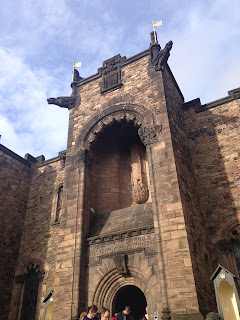Edinburgh Castle
Edinburgh Castle is an incredible place. It sits atop the whole city. Like a granite sentinel. They say that the actual outcrop has been inhabited for many thousands of years. When your look at the defensive attributes, you perhaps, understand why. It's now been developed around so the Edinburgh you see has an old town and a new town. However, when James the III or the VI were wandering around the castle the view from the bottom of the much smaller city would have been far more impressive than with the old town cluttered around it.
The old town is cluttered around the castle now. The beautiful old town, with its internal courts and dark, narrow alleyways. Edinburgh does a neat trade in ghost walks and the legends of the body snatchers haunt the area of the grass market.
Though, of course, the castle as we know it began development in around the 12th century, by David and the chapel that still sits centrally within the castle walls. It's a tiny one room chapel, often snug with tourists who try to squeeze themselves in and out the smallest doorway in Scotland.
Around this, various palaces and buildings have been created by Kings, Queens and Princes century after century to what we can visit now. For example it holds the largest gun ever fired in the British Isles, Mons Meg. James II & III had a passion for guns and artillery.
It is a large piece of ordnance. Then throughout the rest of the site you have royal palaces and other buildings that have now become military museums. All of them interesting, of course. The Scottish honours were fascinating and the door you go through to see them is remarkably thick.It is worth the queue though. The stone of Scone sits within the glass cage, along with the sceptre, the sword and of course, the crown. It reminds that I have never seen the English crown jewels, nor have I ever been inside the Tower of London. This seems a huge gap in my historical tours around the country. Dover Castle, too. That would be a nice trip. It is, though, so far away from where we are.
One of the most impressive buildings, once you have walked away from the Royal palaces, is the National War Monument for Scotland. It is quite an incredible place. It is one of the most serene and contemplative places I have been in. Within the solid walls lies the records of all the lost Scottish soldiers who have fallen for the United kingdom. And for all the times Scotland has been turned over by, deceived by its more powerful southern neighbour, it has always fought, and fought hard. They have died in war zones across the world and in large numbers. The Scottish regiments of the British Army have for 400 or so years acted as the vanguard of the army. The first into battle and often with the heaviest loses. All this is commemorated solemnly within these walls.
It is a startling place. From the Indian sub-continent to North America. The middle east to Europe. The Scots have laid their lives on the line.
We were spent the majority of the day wandering around the buildings that create the castle. It is a remarkable site and reminds me in so many ways of Prague castle. That one, too, is a large area made up of a few different buildings. More of a small royal village that has grown to be seen as a castle. It isn't in the classical sense of the word. It is though, regardless of definition, a very wonderful place to visit.
It is a large piece of ordnance. Then throughout the rest of the site you have royal palaces and other buildings that have now become military museums. All of them interesting, of course. The Scottish honours were fascinating and the door you go through to see them is remarkably thick.It is worth the queue though. The stone of Scone sits within the glass cage, along with the sceptre, the sword and of course, the crown. It reminds that I have never seen the English crown jewels, nor have I ever been inside the Tower of London. This seems a huge gap in my historical tours around the country. Dover Castle, too. That would be a nice trip. It is, though, so far away from where we are.
One of the most impressive buildings, once you have walked away from the Royal palaces, is the National War Monument for Scotland. It is quite an incredible place. It is one of the most serene and contemplative places I have been in. Within the solid walls lies the records of all the lost Scottish soldiers who have fallen for the United kingdom. And for all the times Scotland has been turned over by, deceived by its more powerful southern neighbour, it has always fought, and fought hard. They have died in war zones across the world and in large numbers. The Scottish regiments of the British Army have for 400 or so years acted as the vanguard of the army. The first into battle and often with the heaviest loses. All this is commemorated solemnly within these walls.
It is a startling place. From the Indian sub-continent to North America. The middle east to Europe. The Scots have laid their lives on the line.
We were spent the majority of the day wandering around the buildings that create the castle. It is a remarkable site and reminds me in so many ways of Prague castle. That one, too, is a large area made up of a few different buildings. More of a small royal village that has grown to be seen as a castle. It isn't in the classical sense of the word. It is though, regardless of definition, a very wonderful place to visit.





Comments